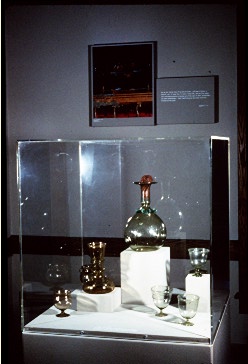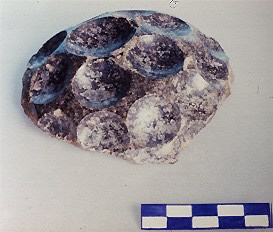

Through mold-blown inscriptions such as these we glimpse something of the glass-makers themselves. Regrettably, however, inscriptions of glass-makers on objects other than their products are very rare. For all the interest taken by Roman authors in the qualities of glass, allusions to the people who created it are few and far between. One curious story passed down from Pliny to Isidore of Seville describes the fate of a glass-maker at the court of Tiberius (A.D. 14-37). The craftsman demonstrated to Caesar that he had invented a means of tempering glass so that it would not break when dropped but could be hammered back into shape like a bronze vessel. When the man admitted that he alone knew of this new treatment for glass, Tiberius had him beheaded "lest when this became known, gold would be valued like mud, and the values of all metals be debased." To what could this tale possible refer? It is tempting to postulate that it has something (however obscure) to do with the invention of mold-blowing. If not the actual inventor of mold-blowing, Ennion was certainly one of the very earliest masters of the technique. An Ennion-signed cup found at Corinth in Greece in a sealed deposit together with a coin of A.D. 37-41 now provides us with a firm date for the early range of his career. It dovetails nearly with the setting of this peculiar story in the reign of Tiberius.
Although free-blowing did not offer the advantages of mass-produced uniformity that mold-blowing allowed, the decorative potentials of the technique were seemingly limitless. While free-blowing a vessel, the glass-maker could achieve a variety of surface effects by drawing the glass out in fin- or thorn-like projections, by pinching it, by ribbing it or corrugating it, or by indenting it at regular intervals. Once blown, a vessel could be decorated with thick or thin threads of molten glass trailed on the surface to produce simple coil accents, zigzag patterns, undulating "whisker" trails or complex sculptural effects. Similarly, blobs of molten glass (usually dark blue) could be fused onto the vessel surface either in simple chains or in complex geometric arrangements. Decorative glass attachments of contrasting colors could be fused to the warm glass vessel also. These could be molded elements such as rosettes, lion-heads, theater masks, and the like (Pl. 16); or they could be free-blown attachments. Applied elements were often set at the base of the vessel's handle. Sometimes they were used all over the vessel's surface, however.
Once cooled, glass vessels could be decorated with cutting techniques performed with emery-fed wheels of different sizes. Essentially, these techniques exploited the structural similarities of annealed glass to compactly grained stone. Undoubtedly, there was a good deal of overlap between artisans who specialized in gem-carving and those who cut and engraved glass. This is no where more evident than in glass cameo work. Blanks for glass cameo vessels were made by casing dark (usually blue) glass with opaque white glass. When cooled, the exterior surface was cut back to produce figural compositions on multiple planes which exploited the shading variations made possible depending upon the degree of thickness or thinness of the reserved white. Cameo glass had an advantage over cameo carving in shell or stone in that the artisan could control the placement and relative depth of the contrasting materials in his blank. Cameo glass was a development emerging from the prosperity of the Pax Romana of the Augustan period in Rome (27 B.C. - A.D. 14). The technique seems not to have been practiced in ancient Italy after the first century A.D. Only thirteen complete cameo vessels are presently known worldwide. Preserved fragments number only in the hundreds.
Dionysiac scenes seem to have been the favored subject matter for cameo vessels. Epic legends were also represented (as, on the famous Portland Vase in The British Museum an enigmatic mythological/epic tale unfolds). Suetonius tells us that the Emperor Nero (A.D. 54-68) "upset the table and dashed to the floor two favorite goblets which he called 'Homeric' after the Homeric tales carved upon them." These goblets were probably cameo-carved. The preciousness of cameo vessels is suggested by a still life painting from Herculaneum in which a cameo-carved jug bearing a scene with a horse and rider figures prominently.
Mythological scenes were also engraved into colorless glass vessels. Alexandria produced a coveted class of this genre during the second century A.D. Fragmentary examples of this ware from Karanis prove that such glasses must have been made in Egypt, no doubt at Alexandria, for the inhabitants of provincial Karanis were not likely to import luxury items from Rome, Cologne, or Sidon. Completely preserved vessels of this type found in the West document complex captioned figural scenes. Vessels which were wheel-cut with elaborate designs of facets and grooves were also greatly prized. Some of these were executed on exquisitely thin glass; while others embellish weighty vessels.
On the eastern frontier of Rome's active military purview, massive clear vessels embellished with deeply cut facets were a specialty.

Fragment of a Partho-
Sasanian faceted bowl
Greenish glass now devitrified and opaque
D. 10.5 cm
Second century AD
Seleucia (UM excavations)
KM 36358
Whole vessels of forms similar to our fragment excavated at Seleucia have been found in Japan. One was buried with the Emperor Ankan in A.D. 535. Unlike the devitrified examples found in the Middle East, the cut-glass vessels exported to Japan are still in pristine condition--their facets dazzling like so many mirrors. To date, no actual examples of such western ware have been found in China; but on a painted silk banner from the Buddhist caves at Tun Huang, a Boddhisatva holds one of these Partho-Sasanian faceted bowls so that his hand is visible through the sparkling pale green glass. Thus, this striking portrayal vividly documents the presence of western glass at a remote outpost along the Central Asian Silk Route. Further evidence of the Chinese interest in glass from the world of Rome comes in the form of lyrical poems composed by the nobility in praise of such luxury vessels which had ". . . braved the perils of the desert's limitless wastes, / And crossed the towering, precipitous Pamirs" in order to grace their tables:
Despite the vernal splendor of its hue,The tour de force of Roman glass-making was the diatretum technique, whereby a blank vessel was cut back to reveal a complex design connected only by narrow reserve struts to the remaining solid wall. One type of diatretum found almost exclusively in the Rhineland was the cage cup variety carved as a lace network around the exterior of the vessel. Figural diatreta such as the famous Lycurgus Cup have a wider distribution. One, depicting the Lighthouse of Alexandria, was found in a hoard of treasures at Begram, near modern Kabul in Afghanistan. These figural diatreta are understandably rare. After Roman times, the technique of diatretum carving in either mode was not attempted again until the nineteenth century when deliberate imitations of the Roman cage cups were made in Bavaria. The extraordinary delicacy of the Roman diatretum vessels suggests the possibility that they were created on a special commission basis -- the glass-carver traveling with the blank vessel to the place where the commission originated. It is difficult to imagine how the Lighthouse diatretum could possible have arrived at Begram intact had it been carved before the arduous journey from Rome or Alexandria. So delicate and specialized was the carving process that a law was formulated to deal with the contingencies of liability for a faulty product, depending upon whether the blank vessel was inherently flawed or whether the glass-carver's ineptitude alone was responsible for a ruined effort.
Its clarity surpasses the purest winter ice.
There vessels are produced as though ceramic,
And their rare foreign shapes richly embellished.
Up to this point we have discussed decorative techniques of the Roman glass-maker which essentially exploit the potentials for textural variation. Nuances of color were, however, equally important qualities of glass--appreciated and exploited with finesse by glass-makers in the Roman period. One technique of great versatility in its applications was fused mosaic work or millefiori , which is an Italian word meaning "1000 flowers." Essentially this technique involves the fusing of colored strips of glass into a rod from which slices can be cut which will present on their sliced surfaces the section-pattern of the fused colors of the rod. These slices of patterned glass were used decoratively as inlays; and they were also fused into the glass matrices of beads and vessels to form overall patterns against a dark ground.
Sometimes vessels and wall inlays were created using the millefiori method but placing the various colored and patterned elements in figural compositions. Elaborate landscape effects were achieved to the extent that it is sometimes difficult to remember that these designs were executed in fused glass rather than in paint. Interestingly, one vessel fragment preserves a section of a mosaic glass landscape of birds among branches and flowers which is very reminiscent of a Dynastic Egyptian vignette of birds in an acacia tree seen, for instance, in the Middle Kingdom tomb painting of Khnemhotpe.
There were many variations on the concept of fused mosaic glass. Gold-band glass was a luxury ware in which gold leaf and swirls of colored glass were fused within a sandwich of colorless glass. Emerging out of the tradition was the technique of gold glass -- where figural representations in gold leaf were sandwiched in colorless glass. This method of decoration was used effectively in the late Roman period for the embellishment of cup tondos. These tondos have been preserved as detached elements because their owners broke them away from the surrounding cup walls in order to imbed them in the walls of the catacombs as funerary emblems. The appeal of the gold-glass tondos for this purpose lay in the fact that they were comissioned pieces, often including a representation of the owner and an inscription giving his or her name or a salutation. Many of these gold-glass tondos supply important material for the study of the iconography of Judaism and Christianity in the first half of the first millennium A.D.
In addition to the traditions of coloristic effects which relied on the fusion of variously colored glasses, the glass-makers of Roman times also developed the technique of enamel painting onto the surface of glass vessels.